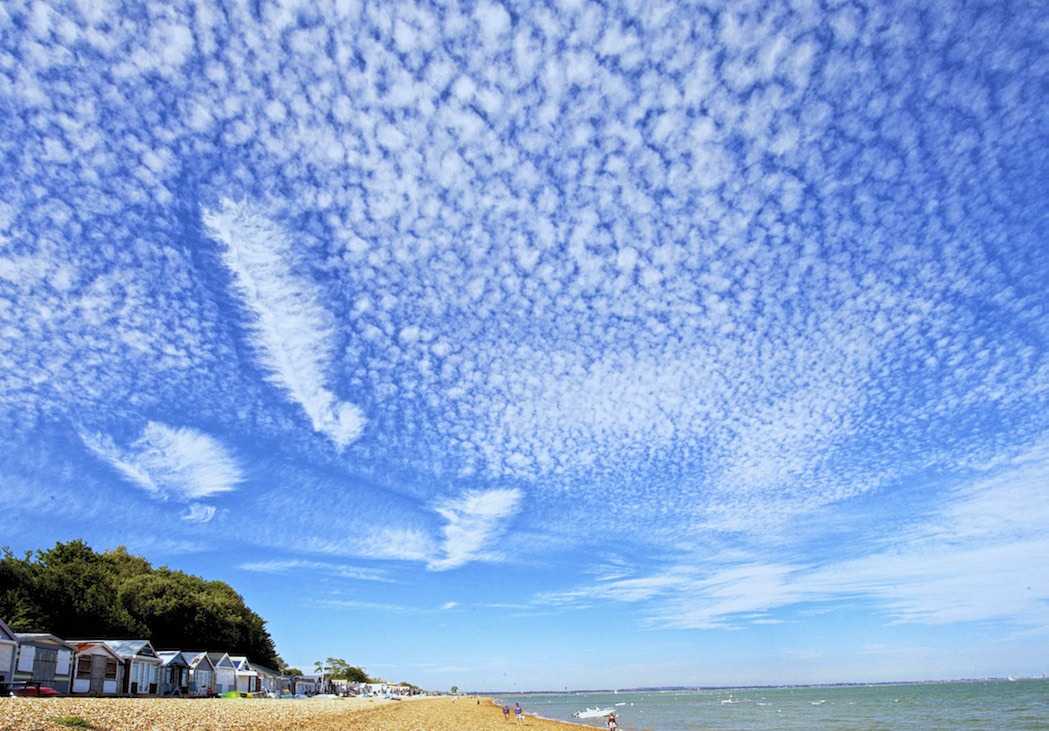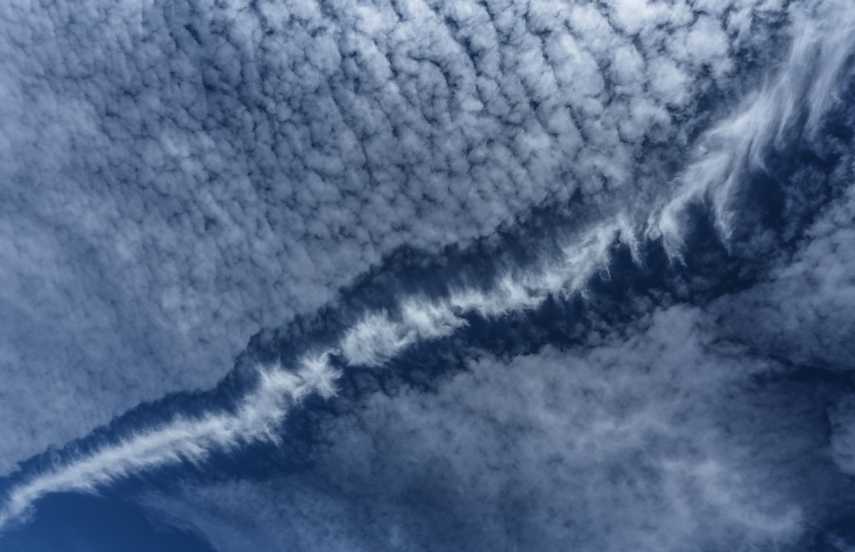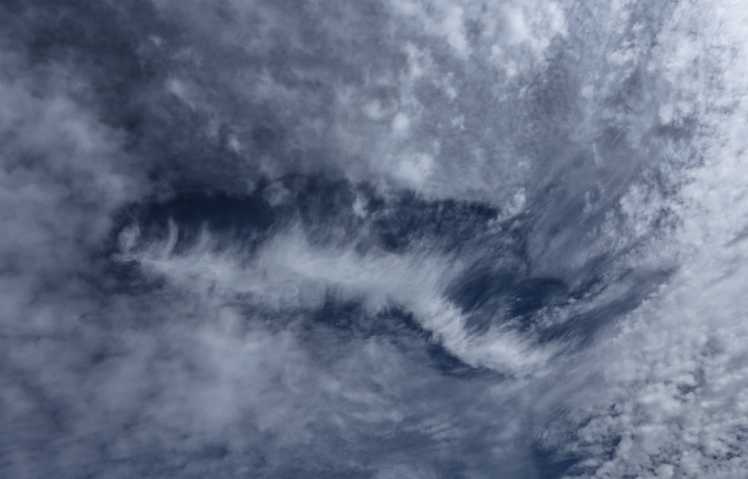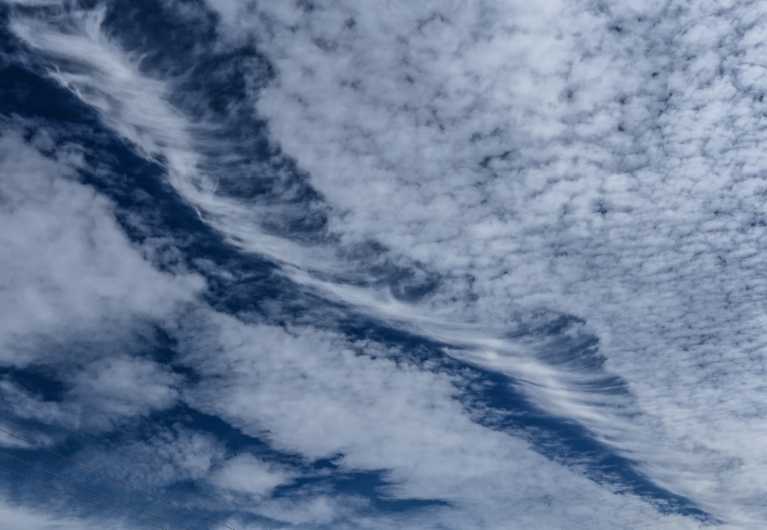Fall streak, mares tails, feather clouds? I'm confused. Taken in Hampshire.
Forums › The Cloud Forum › Fall streak, mares tails, feather clouds? I'm confused. Taken in Hampshire.
- This topic has 11 replies, 7 voices, and was last updated 7 years, 2 months ago by
 Gavin Pretor-Pinney.
Gavin Pretor-Pinney.
-
AuthorPosts
-
-
September 17, 2018 at 2:16 pm #295798
Janet Sutton
Participant
-
September 17, 2018 at 11:00 pm #295863
Howard Brown
ParticipantHi, Jan, from a Hampshire (UK) hog. As you say, likely a fallstreak hole or cavum in new speak.
https://cloudatlas.wmo.int/clouds-supplementary-features-cavum.html
I guess your confusion might be
a) the two features below and either side of the hole
b) the infill to the hole which is not typical virga
Me too. Great picture.
-
September 18, 2018 at 2:30 am #295890
 George PreoteasaParticipant
George PreoteasaParticipantThis is a nice one. There seem to be multiple fallstreaks in the same hole, so to say. The fact that there are three distinct holes (at least that’s what I see clearly) says that there is significant air traffic, which is considered to be the cause of this phenomenon. In this case, it would not be impossible for fallstreaks to form in close proximity and eventually merge. Perhaps planes follow the same routes. Just my thinking.
-
September 18, 2018 at 6:45 am #295912
 Michael LerchParticipant
Michael LerchParticipantJan, Greetings! Fallstreak , Cavum, is the cloud of the month so allow me to continue what you’ve started here.
Heres a shot of a cavum that stretched from one end of the Valley (west) to the other ( yes, east). It was over the north side of the Valley, exactly where many a jetliner can be seen thru out the day. So its a safe assumption this cavum was created by a jetliner stretching 50-60 miles thru the altocumulus.

-
September 18, 2018 at 5:00 pm #295980
 Patricia L KeelinParticipant
Patricia L KeelinParticipantWow, Michael, what a gorgeous shot! Definitely has your signature in it.
-
October 1, 2018 at 11:59 pm #299686
Howard Brown
Participanthttps://earthobservatory.nasa.gov/images/5904/cloud-formations-off-the-west-coast-of-south-america
I am struck by the similarity of the inside of cavum to actinoform clouds.
-
-
September 19, 2018 at 12:01 am #296025
Howard Brown
ParticipantThat’s a good hypothesis, Michael, and a good picture to boot – it would solve the ‘middle of the hole’ confusion.
However, Jan’s picture I would guess (since it is not far from my stamping ground) is looking east with Hampshire to the left and out of view to the right the Isle of Wight. That is not an area with many jetliners, though there could be turboprop airliners heading west towards nearby Bournemouth International Airport. Also Southampton Airport is close, slightly inland. Jetliners passing over tend to be higher with no regular route.
-
September 19, 2018 at 6:36 am #296058
 Michael LerchParticipant
Michael LerchParticipantMy apologies hygge, I wasn’t trying to asuage Jan’s confusion. imho, everything fallstreak in the photo is fallstreak. Fallstreak ,like Virga,falls, the difference being source. But an ice crystal is an ice crystal and they team up and get heavy and fall. I was making comment on my pic only, which spurred me to go back and check some data. I found some interesting info if any care to further eliminate any confusion.
Two pics below; The first is of the beginning of the cavum , photographed at 10:09a.m.. Obviously mature in that the fall is mature well developed ,and already the winds are having their way with it. The shot Above, looking West was taken at 10:50 a.m.. The 2nd shot below, looking East, was taken at 10:55a.m…So, it took apprx 40 minutes to propagate across the Valley.( est the plane took 3 minutes at most to traverse the same sky.).I wonder how close to scientific observation does that rate align? about 50miles to 60miles in 40 minutes..somewhere around 90miles an hour triggering rate?? I have no idea if that means anything or is close to fact.
Another thing of interest that has me slightly confused , occurring while discussing cavum and their source, of course airliners are not the only source to trigger the chain reaction of cold water turning to crystal and falling out of the sky. So heres the observation we mite take,,during our perusal of paintings and art from caveman to Rothko..how may recordings of cavum is there? There are lenticularus in medieval works of art ( thx to GPP for pointing that out in the CG) We have Couch and Tate etc for more modern takes of the sky. And the recent Surrealists to Post Modern to whatever ,have some kind of representation of the sky. Fallstreaks anywhere? In other Arts, there are many references to Angels and their feathers( the beginning of Beethoven’s Leonora..?).but in the visual arts, It may interesting to see when man first started recording the sight of a cavum as a cavum.


-
September 21, 2018 at 11:29 pm #296500
Howard Brown
ParticipantThanks for your thoughts, Michael.
I think this unique CAS picture confirms for Jan that her cavum is indeed cavum
Unique since page 9, the Introduction in Richard Hamblyn’s book Extraordinary Clouds, Met Office, David and Charles, 2009, says ‘Take the image on page 73 for example, which shows the unusual sight of a fallstreak hole illuminated by the prismatic brightness of a circumzenithal arc. It was taken by the Cambridge-based photographer John Deed who came across the sight by chance while taking his son to football practice one cold September morning: “While he was warming up to play I went for a short walk. When I looked up above me there was this large tongue-shaped hole in the cloud. This was interesting in itself but then I realized that there was a rainbow at one end or, as I now know, a CZA. And as I looked closer there was a second one further down, although it does not show up on the picture very well.” A few days later, this rare – possibly unique – capture of a fallstreak hole with a double CZA is donated to the CAS’s photo-archive, and something entirely new was added to the global repertoire of clouds.’
-
September 22, 2018 at 3:20 am #296525
 George PreoteasaParticipant
George PreoteasaParticipantHygge, John Deed’s shot is incredible, but I never heard of a double CZA. Nor can I find references. The bright one is a CZA, IMO, but the fainter one is something else. I am sure Hans can identify it.
-
September 23, 2018 at 8:46 pm #296758
 Hans StockerParticipant
Hans StockerParticipantHello Jan, you made a fantastic picture of these fallstreak holes.
Michael: I am amazed by the picture of this long fallstreak hole made by a plane. together with your precise observations you put also a nice and interesting question forward: Are there any fallstreak holes known in art before the existence of airplanes?
I am sure fallstreak holes must have been observed in years in the plane-less area of our history, for indeed a plane is just one of the possible sources of a fallstreak hole. The process can also be triggered without a plane in a natural way. Who will come up with an answer or example?
George: thanks for confidence in me about an explanation and although there will be questions I can’t answer, this is one I positively can answer. As you already suggest two CZA’s are simply physical impossible. With a given position of the sun and a given position of the observer there is only one place in the sky the CZA might appear when the conditions are right. The second more faint arc in between the sun and the CZA is ‘just’ the upper part of the 22 degrees halo (maybe or maybe not combined with the upper tangent arc).
I hope I don’t disappoint anyone with this analysis, but the picture itself is as amazing as it is and I love it very much. I can only hope to observe these three phenomena together once myself. Wow! And nice to remember this fantastic picture by John Deed from 2007 Hygge.
-
October 3, 2018 at 10:40 am #300328
 Gavin Pretor-PinneyKeymaster
Gavin Pretor-PinneyKeymasterYes, I think that Richard Hamblyn got the classification of optical effect wrong here. It is of course a circumzenithal arc and the top of a 22-degree halo, as Hans suggests. Well spotted, Hygge, George and Hans.
-
-
AuthorPosts
- You must be logged in to reply to this topic.






